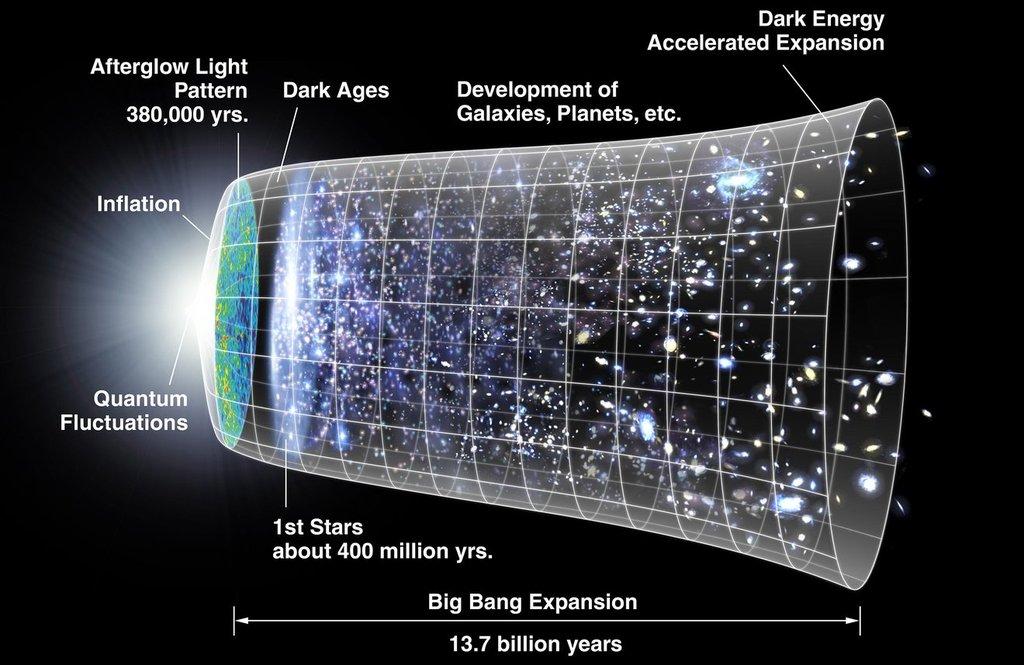Astronify - Astronomy For Beginners - The Expanding Universe
THE EXPANDING UNIVERSE

Expansion Funnel/NASA
Have you ever gazed up at the night sky and wondered about the vastness of our universe? But what if I told you that the universe is not just a static backdrop but a dynamic and ever-changing entity? Let’s explore the captivating physics behind the expansion of the universe.
The Puzzle of Cosmic Motion and Hubble’s Discovery
In the early 20th century, astronomers were astonished to discover that light from remote galaxies was redshifted i.e. the wavelengths of light stretched out and became longer, causing the light to shift towards the red end of the color spectrum. Imagine you are standing on a sidewalk, and a friend is riding a bicycle away from you. As your friend moves farther away, the sound of the bicycle bell appears lower in pitch (Doppler effect). This change in sound is similar to how Redshift works for light.
In our cosmic narrative, a brilliant astronomer named Edwin Hubble, armed with powerful telescopes, made a groundbreaking observation: This redshift indicated that galaxies were moving away from us, and the farther they were, the faster they receded. This led to the formulation of Hubble’s Law, providing the first compelling evidence for the expanding universe.
Imagine the universe as a delicious loaf of raisin bread baking in the cosmic oven. As the bread dough rises, it carries the raisins along with it, making them move farther apart from each other. Similarly, the expanding universe pushes galaxies away, causing the fabric of space itself to stretch.
The Big Bang and Inflation
Now, let’s rewind the cosmic film to its very beginning — the Big Bang! The expanding universe theory suggests that the entire cosmos originated from an incredibly hot and dense state around 13.8 billion years ago. At that moment, all the matter and energy in the universe were compressed into an unimaginably tiny point — a singularity. The cosmos expanded and cooled, initiating the formation of subatomic particles, atoms, and eventually, galaxies and stars.
Take a deflated balloon, and mark some dots over its surface. Blow air into it suddenly. As you blow, the balloon rapidly expands, stretching out the surface and pushing all the dots (representing galaxies and particles) farther apart from each other.
During the earliest moments of the universe, a rapid and exponential expansion occurred, stretching space faster than the speed of light — Cosmic Inflation. This inflationary epoch smoothed out irregularities, setting the stage for the emergence of the vast cosmic web of galaxies we observe today.
The Race of the Galaxies
Picture galaxies as little cosmic runners on a stretching rubber sheet. The more space stretches, the faster the galaxies move apart. The rate at which space is expanding determines how fast galaxies are receding from one another, known as the Hubble constant, named after Edwin Hubble. Measuring the Hubble constant allows us to estimate the universe’s age and understand its future destiny.
Tug-of-War: Gravity vs. Dark Energy
As we know Gravity, the fundamental force of attraction between massive objects, endeavors to slow down cosmic expansion by pulling the galaxies towards each other. However, as our cosmic tale unfolds, we encounter an enigmatic player — Dark Energy.
Dark energy, a mysterious form of energy that pervades space, acts as an opposing force to gravity. Unlike gravity’s attractive nature, dark energy exerts a repulsive effect, causing the universe’s expansion to accelerate. The discovery of dark energy’s existence shook the foundations of cosmology and revealed that the expansion of the universe is not a decelerating process, as once thought, but an accelerating one.
Remember the impact of expansion on smaller scales. Due to gravity, local matter clusters together. As a result, they no longer move away from each other. Hence, the Andromeda galaxy, bound to the Milky Way, is moving toward us and not expanding out.
The Fate of the Universe
As we approach the final crescendo of our cosmic symphony, the ultimate question arises: What is the fate of the universe? The answer depends on the interplay between gravity’s attractive force and dark energy’s repulsive influence. Let’s look into these theoretically modeled scenarios:
Big Crunch: If gravity eventually overcomes dark energy, the universe could experience a “Big Crunch,” where the expansion halts and the universe contracts, potentially leading to a new singularity and a cyclic model of the cosmos. This is less likely to occur as of current observations.
Big Rip: If dark energy’s influence continues to dominate, the universe’s expansion will escalate indefinitely, tearing apart galaxies, stars, and even atoms, as the fabric of spacetime stretches to its limits.
Big Freeze(Heat Death): This is one of the most widely accepted scenarios based on our current understanding of the expansion of the universe. In this scenario, the universe will continue to expand at an accelerating rate due to the influence of dark energy. As a result, galaxies will move away from each other, stars burn out, and everything becomes cold and dark, leading to a state of maximum entropy with no usable energy for life or structures. The universe will become an infinite and lifeless expanse.
To Infinity and Beyond!
In conclusion, the expanding universe is an awe-inspiring revelation that challenges our perception of space, time, and the cosmos. As the universe continues to expand, objects beyond the cosmic event horizon become unobservable, as the emitted light cannot overcome the expansion. This means the farther galaxies that we observe today will disappear in the future. Enjoy while it lasts, fellas!
Emilin Clenson
Astronomer
No comments yet. Login to start a new discussion Start a new discussion